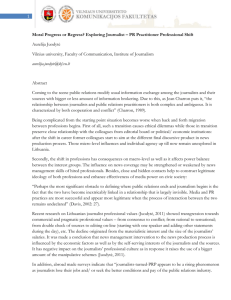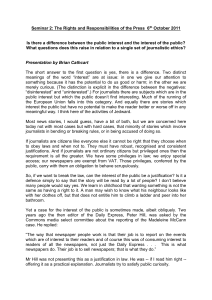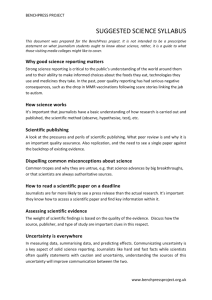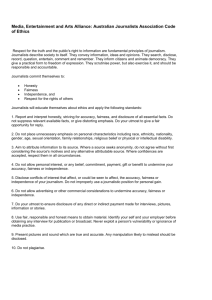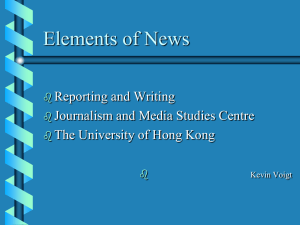Social media in Egyptian newspapers
advertisement
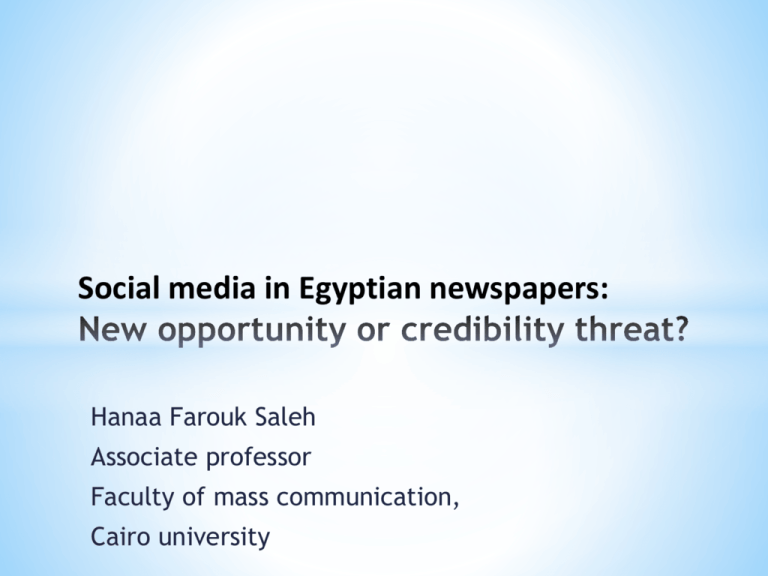
Social media in Egyptian newspapers: Hanaa Farouk Saleh Associate professor Faculty of mass communication, Cairo university * In Egypt and the Arab world social media had brought a lot of surprises, by changing political theater and changing game rule in so called “Arab spring”. Before 25th January revolution, from 2006, social media had played a vital role in mobilizing people to participate in hundreds of protests against the Mubarak regime When it emerged in 2004 that Mubarak might transfer power directly to his son. * Egyptians have been quick to take up the opportunities for activism and citizenship offered by new digital media technologies. * Just before the revolution “We Are All Khaled Said.” page gave the chance to public opinion to be more aware as additional information becomes available to more people within the public sphere, participants discuss more topics, debate, and advocate for. * The page caught on and, in the weeks before the revolution, the page had more than 350,000 followers who were invited to protest against the regime on 25 January 2011. Many of these followers replaced their personal pictures on Facebook with images of Saeed’s face (pre-and/or post-death). The influence of the social media was exaggerated, giving Facebook credit for starting the revolution. Indeed, social media were applauded. Protestors all over Egypt started carrying banners denouncing the government-owned media and calling them “liars.” In the meantime, the primary sources of news for Egyptians became Al Jazeera and political talk shows on other satellite channels, as well as social media. * After June 30 social media role decreased, Still one source of information, but not very valuable as it can be used to harm a person's reputation and image, used for blackmailing, tool of propaganda and political interest, spreading rumors, and sometimes panic distributor: by publishing false information stressing catastrophe such as Nile water pollution, contagion from disease, death of public figures… etc. * While past journalist research do not assess how often journalists are using social media for journalistic purposes, This study considered the frequency of use an important consideration given the possibility of a discrepancy between perceived social media's importance and actual use of it and evaluation of credibility implications which may harm journalist's job and media ethics, particularly in the aftermath of January 2011, professional journalists were sometimes eager to publish first and verify later. * The research aims to know How frequently Egyptian journalists use social media as a professional tool? Did they perceive it as a credible source? Whether their social media use affected by gender, age, length of professional career, specialization and media ownership… to understand the effect of social media on newsroom organization and news distribution in traditional print newsrooms in Egypt. * However, there have been few attempts to demonstrate empirically the linkage between journalists’ evaluations of social media’ credibility and their professional use of it. Egyptian journalists have not received much research attention in Western academic circles. In spite of media's role in history and its development status. Most past studies on studies of online news and social media credibility, focus mainly on citizens as the evaluators (e.g. Bucy, 2003; Flanagin and Metzger, 2000; Johnson and Kay, 1998,2002; Schweiger, 2000). Therefore, this study fills a gap in the literature, which in turn can help us to understand the relationship between traditional and online journalism. H1:There is a positive relationship between social media credibility and journalists adoption of it as a source of information in their work. H2. Demographic and informational variables (gender / age / profession / Education /specialization / Years of Experience / position ) affect the relationship between social media credibility and journalists reliable on it and social media credibility. * H3. There is a strong correlation between newspaper ownership patterns and the use of social media, and trust on it as a source of information. * As an exploratory research, the study aims to answer the following questions: RQ1. For what reasons did journalists use social media? (News gathering, news reporting, collecting public opinions, interviewing…etc.)? RQ2-What are the most common social media forms used by Egyptian journalists? RQ3- How credible is these tools for journalistic profession? RQ4- What are the advantages and challenges resulting from this dependency on social media? RQ5-Are there any standards which guide journalists’ use of social media? RQ6-are there any differences in usage due to different newspaper's ownership? (Governmental/ party/private)? RQ7- Are there differences in the use of the means of social media within the journalistic institutions and why? Position, age, gender, specialty, years of experience...? RQ8- Who does not use these means and why? RQ9--is there a difference in the use of these tools before the January 25 revolution and afterwards? A cross-sectional survey of journalists from Egypt was conducted during two month Period in February and March 2015. The researcher use non probability sample of readily accessible journalists working in Egyptian newspapers, the use of a purposive or non-random sampling strategy is appropriate for fulfilling the stated purpose of this study. This study used purposeful sampling to focus only on users who engage with social media, as opposed to general sampling. Intentional efforts were made to reach a wide variety of genders, ages and educational backgrounds. * A total of 400 journalists were invited to participate in the study. Only 26.25 % participated and finished questionnaire correctly using face to face interview, and online survey, Data were also collected from newsroom managers too, because they are responsible for developing organizational policies and control editorial decision. A total of 42 (40%) newsroom managers was invited to participate in the research. A total of 18 newspapers was represented in the sample. The survey of journalists was conducted in February & march 2015.A survey was sent via social media and face to face interview in each organization’s newsroom, two months after survey were mailed, 26.25 % (N =105) of the 400 journalists had participated, representing print media, private, government and independent ownership. The questionnaire was administered in Arabic. * The dependent variable is social media credibility. In recognizing that credibility is best measured as a multidimensional construct, this study followed the credibility measurements of earlier studies, Respondents were asked to rate the degree of believability, fairness, accuracy and depth of social media message, I added criteria to test social media credibility which based on media type: traditional and new media, and social media platforms, and source type (official, specialized, public), site genre (specialized, public, private) on a three-point scale ranging from 1 (not at all) to 3 (very). * Another questionnaire portion was devoted to measure social media credibility, journalists and managers were asked questions to know which social media platform credible as a mean for news reporting purposes and how they use it in journalistic work. * One question asked respondents if they use social media for journalistic purposes, the second question asked whether the organization had social media guidelines, 3-point-agreement scale (3 = strongly agree, 2 = neither agree nor disagree, 1 = strongly disagree) was also used to measure items focusing on the respondents’ beliefs about using social media as reporting tools. * Additionally, an open-ended question was posed to “non-adopters”; the item asked respondents to describe their reason(s) for rejecting social media as reporting tools. Descriptive Statistics *A total of 105 (of 400 contacted) newspaper journalists from 18 newspapers participated, representing a response of 26.25%. the average age for reporters (M = 36.17, SD = 12.44) 75.2% of respondents was male, young, their age less than 30 (46.5%), Their experience at work less than 5 years (50%), and managers‘ experiences 15years(30%). They are essentially working in print version (45.7%) versus (40%) in electronic version and (14.3%) in both versions. * They use social media for journalistic purposes (50.5%), and personal matter (35.2%) and (14.3%) use it for both purposes. * 62.6% was graduated from mass communication faculty. Data was collected from three types of newspapers, governmental: 40 (38.1%). Party press: 20 (19%), private: 45 (42.9%). * 100% of participants use social media in general to gather information (22.3%), contact friends (21.8%), explore public opinion (21%), learn new things (19.5%) and finally pass time (15.2%). * 90.5 % of journalists use it for journalistic purposes which are: getting ideas (20.2%), publishing articles (17.8%), searching, background(17.1%), contacting sources (14%), getting photos (11.6%), reading comments (10.9%) and finally contacting readers (7.9%). * Facebook, as the largest social networking site with 1.44 billion users (Facebook, march 2015), was the most commonly used social media platform by participants (33.8%), followed by YouTube (24.2%), twitter (22.6%), google+ (14.2%), Instagram (3%) and finally my space (0.7%). Egyptian journalists rely on social media to cover local events (74.4%) more than international (23.2%), and to get hard news (55.7%) than soft news (44.2%). * The 25th January revolution confirms social media's importance in the profession, (86%) begun uses these tools in the work after the revolution. * 9.5% didn’t use social media for journalistic purposes, mainly because of lack of trust (40%), using unprofessional source and manner (20%), sites are controlled by biased political power and serve political interest (20%) and finally news exaggeration and propaganda tools (20%). Surveys from Shanghai had similar findings, As Liu (2011) explains, Chinese suspicion towards the Internet as the source of news, might come from their uncertainty about website independence, website background, its professional and ethical standards, and policies. Social media credibility: * YouTube was the most credible social media source for journalists(44.2%), followed by google+(20%), twitter (17.8%), Facebook(11.5%), and finally LinkedIn (6.3%) * YouTube credibility seems normal because journalists measure credibility by using different criteria such as videos contain sound and photos which present a factual event from their point of view. A study results show that journalists were highly attuned to the need to evaluate the credibility of information they shared with their followers. That instead of relying on traditional journalistic norms, they tended to use ad hoc criteria, such as whether they knew the source, or whether the information included visual elements. This behavior fits with a long history of perceptions of photos and videos as “true” (Becker, 1991)43 More research must explore the decrease of Facebook (called recently Fakebook) as a credible source in spite of heavy using and daily navigation. * Journalist trust more specialized sites (55.8%) than public one(35.8%) and private one was the least credible (8.4%) Journalists put criteria to help them in judging site's credibility, which are site reputation (28.8%), the source used in it (20.1%), site goals and interests (18.3%), currencies and instant updates and corrections (13.3%), site fame (11.4%) and finally numbers of followers (0.7%) * Journalists trust more specialized sources (37.2%), and official sources (34.8%), followed by public source, but in a small percentage (8.5%), social and traditional media share the same position (7.7%) and finally new media (3.8%) Social media Advantages and challenges: * Social media, from a journalist's point of view, represent a lot of advantages to the profession (90.1%), social media present different opinions (11.8%), it gave services without time limit or space(11.1%), it helps journalist as a new way to publish their opinions, discuss social problems, various sources and accessible information(10.4%), journalists can use it as a platform to express their opinions (9.5%), and viewing opinions similar to them, (9.1%), easy access to sources (8.5%) and finally helping them in choosing ideas (8.1%) * At the same time journalists saw a number of disadvantages in social media, and the most important one is the lack of credibility (20.7%), being biased (17.2%), being unofficial source (16%), impossible to check its factual part (14.5%), bring rumors (13.7%), privileged for youth (9.8%), express opinion of political power with special interest(7.8%) Social media guidelines: * In the total reporter sample, 65 of the 105 respondents indicated that social media guidelines were in place, representing 62 % of the reporter sample. the editorial guidelines represent the main guideline emerging from editorial policy (40.4%), followed by ethical consideration (30.9%), and finally political one (28.5%) Future of social media * Egyptian journalists hold an optimistic view toward social media future in the profession, 66.4% affirm that it will take an increase in importance in the journalistic world versus 23.2% predict the stability of its situation as it is today, 8.4% hold a pessimistic view confirming the decrease of social media use. * According to statistical analysis, H1 was supported, as statistical analyses confirm the positive relation between social media credibility and dependent on social media (R=. 291, P:. 004) and using social media for journalists and reporting purposes. (R=. 315,P:. 002) * H2 was supported partially, there was no difference in social media credibility and usage for professional purposes due to gender, specialization, content type (soft/hard), proximity (local/international), year of experience and position. Except for age, all demographic variables seem not related to credibility or social media use. There is a relation between the credibility of social media platforms and age, youth, under 30, tend to trust more different platforms especially YouTube than older journalists (M= 62, P.004). Age still the most influential variable when studying social media use, there is a difference between generation, young journalists, under 30, rely heavily on social media and use it frequently for journalistic and personal goals. Also A relation exists between age and message content credibility: young journalists also tend to have credibility in social media messages comparing with older and more experienced journalists.(Chi square2. 3529, P.004) * H3 was supported, Using one way Anova, Data confirms a relation between the credibility of social media platforms and ownership, journalists in private newspaper trust more web platforms, especially YouTube than governmental and partisan one. (M= 42, P.003) * Analysis proves a relation between ownership and editorial guidelines, governmental newspapers try to control social media use by using editorial guidelines, as a kind of indirect censorship, which restrict choices especially in the political domain. (Chi-square=13.381, P.001) * Statistical analysis also shows a positive relation between social media messages credibility and years of experience, young journalists trust more social media messages, than old journalists.(Chisquare=2. 3155, P.001), At the same time there is a positive relation between using official source and experience, old journalists trust more official sources (M=42, P.001) * Analysis shows also that journalists working in electronic version trust more electronic and social media than those working in print version which in turn trust more traditional sources. (M=67, P.001). As a consequence, it seems logic to find that journalists working in electronic version trust more different kind of social media more than those working in print version. (M=58. P. 003 * The study represents the first non-western context that attempt to ascertain the role of social media on the Egyptian journalistic world. * Egyptian journalists are likely to hold relatively positive views on social media, and they rely on it heavily to do the job, and their extensive use conforms with social media credibility, which contradict with past research results stressing the journalist's negative views on social media, due to the need to protect the authority of their own profession. * The findings suggest that journalists are adopting social media at a high rate, and that YouTube is the most trustful type. This use represent a promising shift from traditional to interactive source in Egyptian newspapers, and this trend is still in progress, social media represent the start point for journalists, they make decision using it to choose ideas then continuing their investigative reporting using different sources and tools, while documenting using available databases. * Egyptian Journalists use social media, mainly to get ideas, publishing articles, searching, background, contacting sources, getting photos, reading comments and finally to a lesser extent contacting readers, which stress the idea of so called ،audience distribution, regarding media interaction with readers, rather than ،audience participation’. * One important findings were the demographic variables Except for age, ownership and experience, didn’t make a difference in perceiving social media credibility. Social media are as credible as traditional media and sources in Egyptian context, journalists hold a positive view of it and evaluate it positively as valuable tools. Even full of rumors and unprofessional manner, propaganda, political control… etc.., Egyptian journalists use heavily social media means as a source of ideas which will be completed later and checked using different sources. The result supports the finding that demographics are weak predictors for media credibility (Johnson and Kaye, 2000b, 2002). * This fact is true in different media ownership in Egypt, the difference between them exist not in using social media, but the way of using it, as a source of ideas for governmental newspapers and a tool for investigative report in the private one. Social media represent a complementary tool for journalistic work which mean new opportunity and chances for journalism in the future. Journalists perceive social media not as a threat or replacement, but a complementary tool for their work, it gave them ideas, facilitate communication with readers and help connecting sources, provide instant feedback… etc.. * It seems to be a promising future based on the findings confirming the increasing use of social media in the work routine (gathering information, contacting sources, ideas, researching…), newspapers begun to hire a social media editor, to surf social media and serve reporting, and there is no editorial policy prevent journalists from using social media. There exist indices which confirm my optimistic view according to the findings: 92.6% of journalists confirm that social media has become an important tool for journalistic routine, and 90.5% assure that they can’t work without social media, it represents an essential tool for journalistic work. * This study contributes to media credibility research by examining journalists criteria to evaluate credibility of social media, generally credibility research focus more on audience credibility criteria, but journalists aren’t only audience, they are opinion leaders and they are responsible, as people representative, to judge the credibility and seeking truth. The study proposes model need more test in a different context, I believe that when journalists come to trust social media their assessment is based on five dimensions which help in measuring credibility from a journalist's point of view: source: which include official, public and expert, message with famous criteria such as objectivity, fairness, balance, accuracy…, media type: traditional versus new media, social media platforms: YouTube, Facebook, Twitter,… etc., and finally site owner: specialized, public, private. * One of the most interesting findings is that social media had narrow gap between poor and rich media organization, although new technology had wider the gap between rich and poor institution, especially political party press, which suffer a lot of a large number of challenges, social media had restrict this gap, by giving journalists in different newspapers type the opportunity to compete using an important tool and give primacy to content, meaning that ideas is more important in the media market and more valuable than the form. So Not only Marginal groups such as women, poor and political opposition benefit from social media, but also journalists which try to serve people as well. *it is quite interesting to note a balance in media credibility from traditional media sources to the Internet and social media sources, especially young journalists, as users gave a higher credibility rating to social media sites as traditional media, despite their lack of the journalistic norm of objectivity.



